
Movies Home / Entertainment Channel / Bullz-Eye Home
There's just something about two great actors going toe-to-toe that makes for some of the most memorable cinematic moments. Call it chemistry if you will, but these days, when you get a couple of Hollywood heavy hitters in the same room, it's usually guaranteed to light up the screen like the Fourth of July. So when it was announced that Michael Mann had enlisted two of this generation's greatest actors – Johnny Depp and Christian Bale – to star opposite one another in his new film, "Public Enemies," we couldn't help but be reminded of the many other classic face-offs starring the industry's cream of the crop. Some are as simple as good versus evil, while others are a little more, well, complicated. Below you'll find a list of our ten favorite match-ups (and what makes them so special), along with five more that just missed the cut.

Blake Edward's epic-length homage to silent comedies and classic adventure films reunited the comedy team of "Some Like It Hot" as absurdly opposite adversaries. As daredevil/race car driver "The Great Leslie," Tony Curtis has a (literally) sparkling smile and an (animated) twinkle in his eye. He sports all-white suits, is a superb swordsman, and random women are constantly pouncing on him for a kiss. Jack Lemmon's top-hatted Professor Fate wears black, has a twirl-friendly mustache, speaks in a ridiculously exaggerated cartoon villain voice, and is a perpetual loser -- forever bested by Leslie's goodness and superior skill. Curtis' performance is an amusing spoof of classic movie heroism and his own status as a matinee idol. Lemmon's Snidely Whiplash-esque Professor Fate, on the other hand, is a completely un-Lemmon-like performance: unrealistic, over-the-top and so absurdly ill tempered as to be kind of likable. Forced to impersonate a spoiled, drunken prince (also played by Lemmon), Fate finds himself on a king-size bed with several friendly pugs and turns to one and says with complete earnestness, "I hate you." Like us, the dog is not one bit scared, and seems kind of amused. – Bob Westal
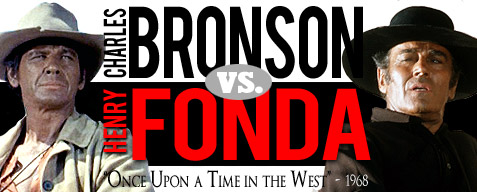
Spaghetti western maestro Sergio Leone ("The Good, the Bad, and the Ugly") was not afraid to go over the top, but his most outrageous act as a filmmaker was the casting of Henry Fonda as one of the most bone-chillingly evil villains ever portrayed, in this epic tale of revenge and empire. The sight of the man who'd been the embodiment of basic human decency in countless Hollywood classics shooting a small boy in cold blood must have horrified audiences in 1968. It remains one of the most indelible moments in the history of onscreen violence, as Leone's camera films Fonda in extreme close-up, where his hint of a benign smile only makes him more terrifying. Bronson's gunman on a mission, on the other hand, is as close to a traditional hero as any Leone character, but he's still got some quirks, and this remains one of Bronson's most subtle and oddly humorous performances. Director Sidney Pollack called Leone's masterwork "an opera where the arias are stared," and the final stare-down between these icons of different eras goes on for what some might consider an absurdly long time. Leone knew, however, that with these two faces, we'd keep watching. – BW
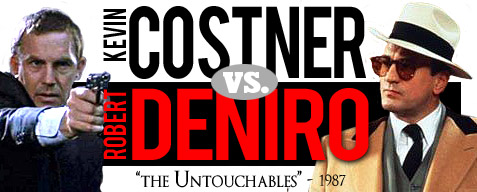
To filmgoers too young to remember life before "The Postman" and "The Adventures of Rocky and Bullwinkle," the idea of a matchup between Kevin Costner and Robert De Niro having any kind of relevance might seem a little silly – but in 1987, Costner was the young and hungry pup who was getting ready to earn critical accolades for "No Way Out," and De Niro was, well, still De Niro. Here, Brian De Palma makes solid use of both, pitting Costner's boyish, clean-cut Eliot Ness against De Niro's shadowy Al Capone, then spinning a typically stylish web around their battle for dominance in Prohibition-era Chicago. Though Sean Connery was the one who won an Oscar for his "Untouchables" work – and, thanks to a remarkably prescient contract wrinkle, walked away with 10 percent of the net – the movie rests on the conflict between Ness and Capone, and would have fallen apart without the charged energy that hums between Costner and De Niro during scenes such as their public confrontation in a hotel. "Public Enemies" follows a different struggle between a lawman and his famous prey, but you can bet it'll need to hold up to comparisons with "The Untouchables" to be considered a success. – Jeff Giles
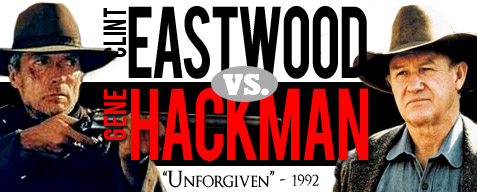
Among good guy/bad guy match-ups, few films of any genre have been as morally knotty as Clint Eastwood and writer David Webb Peoples' western masterpiece. Eastwood's William Munny is a sort of psychopath in remission, "cured" by his late wife of strong drink and the murderous rages that went along with it. Since he's nevertheless on a mission to murder a brutal cowboy and his hapless partner, he should be "the bad guy." Gene Hackman's tough-as nails sheriff, "Little Bill" Daggett, who is trying to prevent the killings, should be "the good guy." However, Daggett/Hackman can shift from hail-fellow-well-met good nature to murderous sadism with the bat of an eye, while Eastwood's kindness to his friends and absolute stoicism in the face of an impossible situation makes him profoundly sympathetic, even as we begin to fathom the nature of the violence he's working so hard to suppress. Certainly, the hateful, torture-loving Little Bill would argue that Munny doesn't deserve our sympathy, while he does – after all, he's on the right side of the law. However, as Munny tells Bill at a crucial juncture in their relationship, "'Deserves' got nothin' to do with it." – BW
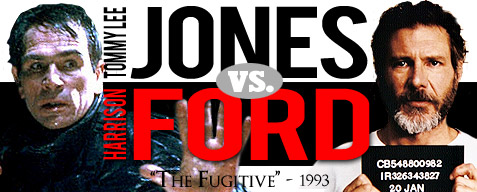
When people speak of old TV shows turned into successful movies, for some reason "The Fugitive" doesn't seem to be a title that's instantly bandied about. Maybe that's because the movie was so successful in its own right that it makes the viewer forget it's even based on a series. While there's no doubt Andrew Davis' direction was obviously a huge factor, the work on display from the film's two leads is what made the movie something extra special. Harrison Ford was riding high with his first Jack Ryan movie ("Patriot Games") under his belt, and there was a general feeling that the man could do no wrong at the box office. Tommy Lee Jones hadn't quite hit his resurgent stride as of yet, although he had scored an Oscar nomination for "JFK" a couple years prior. Together, the combination of the two men lit late summer movie screens on fire in 1993. The audience, of course, knew Ford's Dr. Richard Kimble was innocent of murdering his wife, but Jones brought such dogged intensity and sardonic charm to Marshal Samuel Gerard, that it became difficult to figure out exactly which guy to root for. The pair only has a couple scenes together, but in those few moments of the movie, you just knew cinematic history was being written. Who can forget this simple, yet priceless exchange? Ford: "I didn't murder my wife!" Jones: "I don't care!" Jones went on to nab the Oscar for Best Supporting Actor, and we cared. – Ross Ruediger
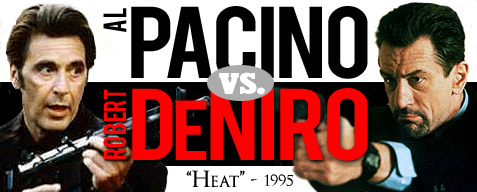
Cinematic showdowns don't come any more highly anticipated than this. More than two decades after sharing billing (but no scenes) in "The Godfather: Part II," Robert De Niro and Al Pacino finally had a big screen showdown in Michael Mann's sleek, stylish 1995 crime epic. Pacino is LAPD Lt. Vincent Hanna, a true-blue cop whose dogged dedication to his job has destroyed two marriages and is on its way to wrecking a third; De Niro is Neil McCauley, a brilliant thief whose ego goads him into attempting the final score that's supposed to finance his retirement – even though he knows Hanna's watching him. Though the two characters share just a few of the 171 minutes that make up "Heat," Mann makes them count, serving up a deliciously tense tête-à-tête in a coffee shop that foreshadows the final showdown between Hanna and McCauley in the film's last act. After all that buildup, some film fans were a little let down by such an understated clash of titans, but now that we've seen what can happen when Pacino and De Niro spend an entire movie together (2008's "Righteous Kill"), those seem like awfully petty complaints. – JG
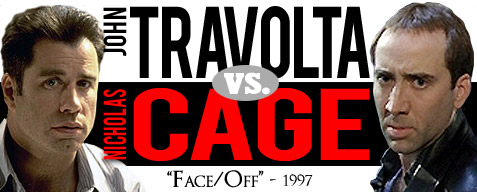
By the time "Face/Off" arrived, John Travolta had already blown through the good karma that "Pulp Fiction" provided him, having spent the previous year shooting the unholy trifecta of "Broken Arrow," "Phenomenon" and "Michael." He needed a hit, and Nicolas Cage was as hot a property as there was at the time (it would be another year before Cage did "Snake Eyes," thus beginning the "Self Parody" phase of his career), so teaming up with Cage and "Broken Arrow" director John Woo made perfect sense. Even better, Travolta and Cage got to play both hero and villain, courtesy of a convoluted story line involving reconstructive facial surgery. This gave each actor the opportunity to ham it up while doing their best impression of the other, a war that Travolta won with his pitch-perfect Cage impression on the line, "It's like looking in a mirror, only…not." Posting a worldwide gross of $245 million, "Face/Off" earned Woo the best reviews of any of his Hollywood movies, and created one of the most delightfully quirky alpha male battles in movie history. – David Medsker
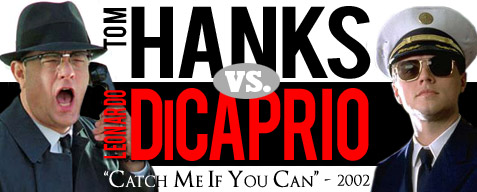
Tom Hanks and Leonardo DiCaprio have a lot more in common than you might think. Both are graduates of a popular '80s sitcom, and both have a classic movie star quality to them that would make even Cary Grant blush. In other words, the duo is a match made in heaven, but when you factor Steven Spielberg into the mix, well, it only gets better. "Catch Me If You Can" probably won't go down as either actor's best work, but the movie is a fizzy cat-and-mouse crime drama that definitely benefits from their involvement. DiCaprio has always had the unique ability to play just about any age, and the fact that he plays several here (both in different time periods and as different aliases) is a testament to how good he really is. Hanks, meanwhile, is clearly just having a blast with his horn-rimmed glasses, G-Man-regulation-fedora and Boston accent. While the pair don't have very much screen time together (the best moment comes in an amusing first meeting where DiCaprio talks his way out of being captured), it's still a memorable match-up, if only for Hanks' unofficial passing of the torch. – Jason Zingale
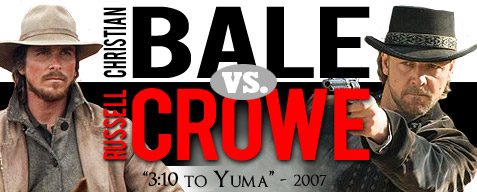
When word first broke that Russell Crowe and Christian Bale, two of Hollywood's pricklier pears, would be teaming up to remake the 1957 western "3:10 to Yuma," pundits set the over/under on the first hostile confrontation between the two actors at five minutes ago. As it turned out, the shoot went relatively smoothly; each actor respected the other's dedication to the craft, though fittingly, the on-screen chemistry between the two is supercharged, as they strive to bring out the best in themselves and each other. Crowe plays bank robber Ben Wade with a casualness that belies his volatile nature, while Bale's Dan Evans, a failed rancher, visibly simmers in his own juices (namely self-loathing and guilt). Either man could explode at any minute, and half of the fun is wondering when each will hit his breaking point. If we're lucky, Crowe and Bale will resume this friendly rivalry at least once more before all is said and done, because these two make beautiful music together. Crowe as the next "Batman" villain, perhaps? – DM
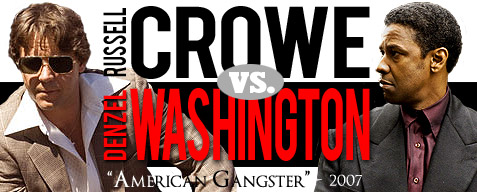
Much like "Heat," the stars of "American Gangster" only truly share one scene together, but that doesn't make the extended sequence any less exciting. After all, the 150-odd minutes leading up to the finale (in which Russell Crowe's down-on-his-luck detective is constantly evaded by Denzel Washington's crafty and cautious drug lord) actually plays an important role in the onscreen match-up. As a product of both the story and the character, Washington commands a majority of the film, but by the time he's been arrested and forced to cooperate with the police, the roles are flipped in Crowe's favor. Washington still comes out swinging with all the bravado you'd expect from a typical performance, but watching Crowe as he calmly pulls the rug out from under him (and in return, seeing his opponent's ego crumble behind a stone-faced expression) is nothing short of genius. Washington may have been the star of "American Gangster," but Crowe more than makes up for his lack of equal screen time by matching his co-star blow for blow. It might just be the first time we've ever seen a power struggle depicted with a single cup of coffee. – JZ
HONORABLE MENTIONS
John Huston's melodrama pitted movie-OG Edward G. Robinson against Humphrey Bogart, who originally became famous playing thugs every bit as nasty as Robinson's "Little Caesar." What's striking here is that, for two of the classic era's greatest tough guys, both are utterly terrified. The fact that Bogart's battle-scarred would-be hero is palpably afraid to kill the thug who is holding him and his friends captive, and Robinson is nearly paralyzed with fear by the thought of gulf coast hurricanes, is actually kind of the point. In real life, heroes and villains are as frightened as anyone, they just behave differently somehow. – BW
It's not very often that the villain gets top billing (especially in a movie named after the main protagonist), but Jack Nicholson certainly deserved it for his over-the-top performance as the Clown Prince of Gotham. Though Heath Ledger and Christian Bale would eventually upstage the duo nearly two decades later, there's nothing quite like an original, and Michael Keaton and Nicholson were nothing if not that in their most famous roles to date. They may no longer be the definitive versions of those characters, but they're still a close second. – JZ
Both as actors and as characters, Ethan Hawke's well-intentioned rookie and Denzel Washington's absurdly charismatic, 100 percent corrupt, utterly ruthless super-cop are badly mismatched. However, the difficulty ordinary people have resisting strong personalities in the central theme of this hyperactive cop thriller, so Hawke's befuddlement in the face of Washington's Oscar-winning, powerhouse performance actually makes some sense. Not everyone agreed that Hawke also deserved an Academy Award nomination for his role, but considering the emotional beating he takes from Washington throughout the film, he probably deserved some recognition simply for remaining visible. – BW
One of Hollywood's most deathly serious actors – and freshly minted Academy Award winner – squares off against Tom Cruise and his piercing "Eye of Sauron" stare, and the results, to our pleasant surprise, were the exact opposite of what we were expecting. Philip Seymour Hoffman deliberately underplays his role as the villain, and his unflappability, combined with Cruise's dogged earnestness, creates a crackling dynamic. (Cruise dangles a bound Hoffman out of an airplane, and Hoffman doesn't even break a sweat.) Cruise would be wise to work with more Oscar winners from here on; they raise his game, which makes sense considering they have something that he desperately wants. – DM
Most American remakes of East Asian films provoke more snickers than applause – but then, most of them aren't directed by Martin Scorsese, nor do they revolve around a nail-biting, high-stakes game of cat and mouse played by actors with the type of mojo carried by Leonardo DiCaprio and Matt Damon. DiCaprio, as undercover cop Billy Costigan, is assigned to infiltrate the mob family led by Frank Costello (Jack Nicholson); meanwhile, Costello sends mobster Colin Sullivan (Damon) to work his way into the police department. It's a brilliant setup for a film, one fraught with tension even though Scorsese keeps his leads separate for most of the movie – and when they do finally throw down, the confrontation is just as explosive as you'd hope. – JG
You can follow us on Twitter and Facebook for content updates. Also, sign up for our email list for weekly updates and check us out on Google+ as well.











